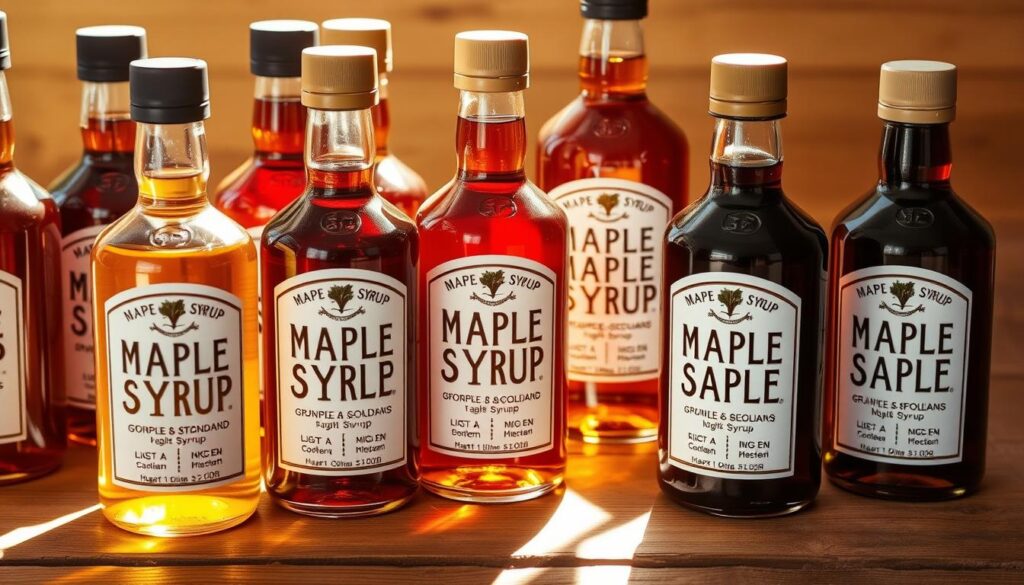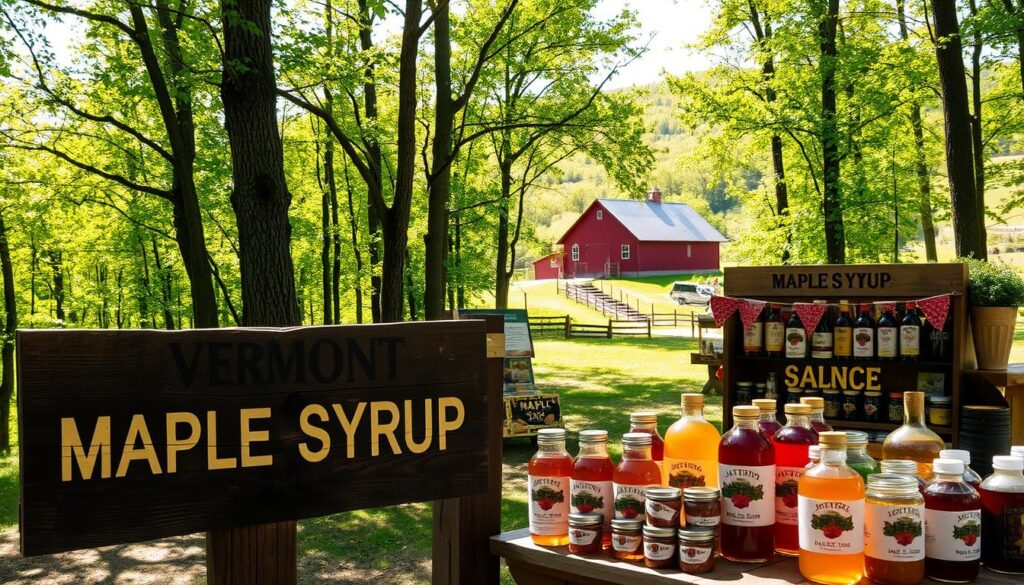Maple syrup production is a treasured tradition in North America. It turns tree sap into a tasty treat that shows off local skills. Learning about maple syrup harvesting is your first step into this world.
The maple syrup season is a mix of nature and human skill. Places like Vermont are famous for this craft, drawing in food lovers. The weather greatly affects how much sap is collected from maple trees.
Creating maple syrup takes patience, care, and a love for nature. Sugarmakers use family secrets to tap into the trees. They know a lot about trees, weather, and how to collect sap.
Every drop of maple syrup is a big change. Raw sap becomes syrup through boiling, making it sweet and amber-colored. This syrup is loved for its taste and health benefits.
If you’re new to this, the maple syrup season is a great time to learn. This guide will help you understand how maple syrup is made. It’s perfect for anyone interested in this craft.
Your maple syrup journey begins here. It’s a mix of science and art, turning sap into a special treat loved everywhere in North America.
Understanding the Maple Syrup Harvesting Season
The sugaring season is a special time when nature’s rhythm creates the perfect conditions for making Vermont maple syrup. It’s a time when maple trees turn from being dormant to producing a sweet liquid that people love. This tradition has been enjoyed by many for a long time.
For maple syrup to be made, the environment must be just right. The magic happens when it’s warm during the day but cold at night. This mix of temperatures makes the sap flow through the trees.
Optimal Weather Conditions
To collect sap, the weather must be perfect. The sugaring season usually lasts 4-6 weeks, from late February to early April. Important weather factors include:
- Consistent day/night temperature variations
- Minimal wind exposure
- Adequate soil moisture
- Minimal precipitation during collection
Peak Harvesting Times
The best time to harvest sap varies by region. In Vermont, the peak season is usually in March. This is when the weather is just right for making syrup.
| Region | Peak Harvesting Period | Average Sap Yield |
|---|---|---|
| Northern Vermont | Mid-March to Early April | 40-50 gallons per tap |
| Southern Vermont | Late February to Mid-March | 30-40 gallons per tap |
| New Hampshire | Early March to Late March | 35-45 gallons per tap |
Regional Variations
The climate greatly affects the sugaring season. Things like elevation, latitude, and local weather patterns impact sap flow. This makes each maple syrup harvest special to its place.
“Every drop of maple syrup tells a story of patience, precision, and environmental harmony.” – Vermont Maple Sugar Makers Association
Essential Tools and Equipment for Maple Syrup Production
Maple syrup equipment is key to making syrup. It doesn’t matter if you’re new or experienced. The right tools can make your syrup-making better.
For professional syrup making, you need specific gear. This equipment falls into a few main groups:
- Tapping Tools
- Spiles (taps)
- Drill bits
- Hammer
- Collection Equipment
- Sap buckets
- Collection tanks
- Tubing systems
- Processing Gear
- Large evaporator
- Reverse osmosis machine
- Filtering equipment
Quality equipment is vital for collecting sap and making syrup. Today’s sugarmakers mix old ways with new tech. This helps them get better syrup.
“The right equipment transforms maple sap into liquid gold” – Traditional Sugarmaker’s Wisdom
Every tool in maple syrup making is important. From tapping tools to evaporation systems, the tech has improved a lot. It helps make syrup that’s better and more consistent.
Newbies should start with basic tools. Then, as they get better and grow, they can buy more advanced equipment.
Identifying the Right Maple Trees for Tapping
Starting with the right maple trees is key to making maple syrup. Not every maple tree is good for tapping. Knowing their differences is important for a good harvest.
For maple tree tapping, it’s important to pick the best trees. Sugar maple is the top choice for syrup. It has the most flavorful sap.
Sugar Maple Characteristics
To spot a sugar maple, look for these signs:
- Bark color: Light gray to dark gray with tight, vertical ridges
- Leaf shape: Five-lobed leaves with smooth edges
- Leaf color: Bright green in summer, vibrant yellow to orange in autumn
- Tree canopy: Typically round and dense
Tree Size Requirements
There are size rules for tapping maple trees:
| Tree Diameter | Tapping Recommendation |
|---|---|
| 10-12 inches | 1 tap |
| 13-18 inches | 2 taps |
| 19-24 inches | 3 taps |
Health Indicators
Check the tree’s health before tapping:
- Absence of dead branches
- Smooth, intact bark without significant damage
- Healthy leaf production during growing season
- No signs of disease or pest infestation
Pro tip: Always use clean, sterilized tapping equipment to prevent introducing infections to the maple trees.
Step-by-Step Guide to Tree Tapping Techniques
Maple syrup production starts with tapping maple trees. Knowing the right techniques is key for a good harvest and tree health. Precision and care are vital during tapping.
Before tapping, you’ll need these tools:
- Clean drill with the right bit size
- Sanitized spiles
- Rubber mallet
- Collection buckets or tubing
- Cleaning solution
Here are the main steps for making maple syrup:
- Tree Selection: Pick healthy maple trees at least 10 inches wide
- Location Preparation: Choose sunny spots with good sap flow
- Drilling Technique: Make a 1.5-2 inch deep hole at an angle
- Spile Insertion: Tap the spile into the hole gently
- Collection Setup: Attach clean buckets or tubing
Avoid common mistakes like drilling too deep or using dirty tools. Always clean your tools to prevent infections.
Experts say to rotate tap spots each season to keep trees healthy and boost sap.
By following these steps, beginners can start their maple syrup journey well.
Modern vs Traditional Sap Collection Methods
Maple syrup farmers have always looked for better ways to collect sap. They use new tech and keep old traditions alive.
Today, collecting sap is much easier than it used to be. Farmers have many ways to get sap, each with its own benefits and problems.
Bucket Collection Systems
Small producers love using buckets to collect sap. This old method involves:
- Hanging metal or plastic buckets on maple trees
- Carrying sap by hand
- Keeping a close bond with nature
Buckets let farmers connect with their ancestors in sap collection.
Tubing Systems
Tubing is a big step up in sap tech. It uses:
- Plastic tubes that follow gravity to collect sap
- Less work for farmers
- Faster sap gathering
Vacuum Pump Systems
Vacuum pumps are the latest in sap tech. They work by:
- Speeding up sap flow
- Shortening collection time
- Getting more sap from trees
Farmers pick their method based on size, budget, and goals. Each way has its own strengths in making maple syrup.
Setting Up Your First Sugaring Operation

Starting a maple syrup business needs careful planning. The first step is to pick the right spot for your operation. This choice is key to your success.
When setting up your sugaring operation, think about these important points:
- Proximity to maple grove
- Access to water resources
- Proper ventilation requirements
- Space for sap storage and processing
The sugarhouse is the heart of your operation during the sugaring season. It should be set up for efficiency. You’ll need areas for:
- Raw sap collection
- Boiling equipment
- Bottling and packaging
- Storage and inventory management
“A well-planned sugaring operation transforms maple sap into liquid gold through meticulous preparation and passionate craftsmanship.”
Your setup should grow with your skills. Begin with basic, quality equipment. Then, expand as you learn more each season.
It’s also important to think about your budget. Buy reliable evaporators, collection systems, and storage. Good planning now means better syrup making later.
Sap Storage and Handling Best Practices
Maple syrup production relies heavily on how sap is stored and handled. Farmers must know how to keep fresh sap quality high. They follow strict steps from when sap is collected to when it’s processed.
Managing sap well is key. It affects the syrup’s taste and safety.
Temperature Control Strategies
Keeping the right temperature is vital. Sap spoils fast if not kept cool. Farmers stick to these temperature rules:
- Keep sap chilled at 38°F or below right after it’s collected
- Don’t store sap for more than 7 hours at room temperature
- Use cold storage or quick processing to stop bacteria growth
Essential Sanitation Requirements
Cleanliness is critical for top-notch maple syrup. Sugarhouse workers must follow strict cleaning rules.
- Clean and sanitize all collection tools before use
- Use food-grade cleaners for storage tanks
- Check transfer lines and storage containers often
- Stop sap from getting mixed up during handling
Pro experts know quality starts with careful storage and handling. By controlling temperature and keeping everything clean, producers make syrup that’s loved by all.
The Art of Boiling Sap into Syrup
Turning maple sap into syrup is a precise art. It’s what sets amateur sugarmakers apart from the experts in Vermont. The boiling stage is key to creating this sweet treat.
To make syrup, sugarmakers remove water by heating it carefully. They watch the temperature and density closely. This ensures the syrup reaches the perfect consistency.
- Initial sap contains about 2% sugar content
- Boiling concentrates sugar to approximately 66-67%
- Temperatures typically range between 219-221 degrees Fahrenheit
There are two main ways to boil sap:
- Traditional Open-Pan Evaporators: A slower, more classic method
- Continuous-Flow Systems: A modern, efficient way
Creating syrup is both science and art. Producers look for color and consistency changes. They must avoid scorching, which requires constant attention and skill.
“Maple syrup is liquid gold, crafted through patience and precision” – Vermont Sugarmakers Association
Quality Control and Grading Standards
Vermont maple syrup production follows strict quality control. This ensures that the syrup is top-notch. Sugarmakers work hard to keep standards high throughout the process.

Quality control starts with watching many factors. These factors affect the syrup’s taste, color, and density. Every step in making syrup is checked to meet top standards.
Color Classifications
Maple syrup is sorted by color and taste. This shows when it was made and its flavor:
- Golden Color (Delicate Taste): Lightest grade, harvested early in the season
- Amber Color (Rich Taste): Medium-intensity flavor
- Dark Color (Robust Taste): Strong maple flavor
- Very Dark Color (Strong Taste): Most intense maple characteristics
Density Measurements
Measuring syrup density is key in Vermont. Sugarmakers use special tools to check the syrup’s sugar content. This ensures it meets exact standards.
| Measurement Tool | Purpose | Ideal Range |
|---|---|---|
| Hydrometer | Sugar Content Verification | 66-67% Sugar Concentration |
| Refractometer | Precise Sugar Percentage | 66.5-67.5% Brix Scale |
“Quality is never an accident; it is always the result of high intention, sincere effort, and skillful execution.” – Maple Syrup Producers Association
High-quality control makes maple syrup a special treat. It’s loved by people all over the world.
Common Challenges for Beginning Producers
Starting in maple syrup production is not easy. New farmers face many challenges during the sugaring season. These include technical and environmental hurdles that need careful handling.
Maple syrup farmers often meet several big obstacles early on:
- Unpredictable weather patterns disrupting sap flow
- Equipment maintenance and possible breakdowns
- Learning how to make syrup with the right consistency and flavor
- Managing time well during the busy sugaring season
Keeping an eye on the weather is key for making maple syrup. Sap flows best when it’s warm during the day and cold at night. This usually means daytime temps above 40°F and nighttime temps below freezing.
| Challenge | Potential Solution |
|---|---|
| Inconsistent Sap Flow | Invest in good weather tracking tools |
| Equipment Reliability | Regular maintenance and professional checks |
| Production Skills | Go to workshops and talk to seasoned producers |
Getting good at tasting syrup takes time and patience. Experienced maple syrup farmers suggest keeping detailed logs of production and weather.
Successful maple syrup farmers know that facing these challenges is part of the journey. They stay persistent, keep learning, and are open to change. This is how they succeed in this traditional craft.
Sustainable Harvesting Practices
Maple syrup farmers are key to keeping forests healthy while making this natural sweetener. They use sustainable methods during the maple syrup season. This helps keep maple groves healthy and protects the environment.
Environmental Considerations
Maple syrup production is more than just collecting sap. Farmers must balance their methods with protecting the environment. They use several strategies to do this:
- Implement selective tapping to reduce stress on individual trees
- Protect forest biodiversity during maple syrup harvesting season
- Use energy-efficient boiling and processing equipment
- Minimize forest floor disturbance during collection
Tree Health Management
Keeping maple trees healthy is vital for sustainable syrup production. Farmers follow strict guidelines to keep trees thriving:
| Practice | Impact on Tree Health |
|---|---|
| Limit taps per tree | Prevents tree damage and supports long-term productivity |
| Proper tap hole placement | Reduces tree stress and prevents infection |
| Regular tree assessment | Identifies health issues early |
Sustainable practices protect the forest and ensure maple syrup production for generations to come.
Marketing Your Maple Syrup Products

Vermont maple syrup farmers have a special challenge in getting their products to market. They need a smart marketing plan. This plan should show off the unique craftsmanship of their syrup. It should also appeal to those who love high-quality, local maple syrup.
Building a strong marketing strategy includes a few important steps:
- Create a compelling brand story that showcases the unique process of maple syrup production
- Design attractive packaging that reflects the authenticity of Vermont maple syrup
- Leverage multiple sales channels to reach diverse customer groups
Local markets are a great place for farmers to meet customers. Farmers’ markets, farm stands, and local grocery stores are perfect for sharing samples. They also help farmers educate and connect with people.
| Marketing Channel | Potential Reach | Customer Engagement |
|---|---|---|
| Farmers’ Markets | Local Community | High Personal Interaction |
| Online Sales | National/International | Broader Market Access |
| Specialty Food Stores | Gourmet Consumers | Premium Product Positioning |
Digital marketing opens up big chances for Vermont maple syrup farmers. Social media, websites, and online stores can showcase their products. Sharing how maple syrup is made can attract customers who want to know more.
“Pure maple syrup is more than a product—it’s a story of tradition, hard work, and natural beauty.”
When setting prices, maple syrup farmers should remember their syrup is special. They can stand out by selling different grades, unique packaging, and special items like maple candy.
Financial Aspects of Small-Scale Production
Starting a maple syrup farm can be thrilling for those in agriculture. Farmers need to look closely at the money side before they begin. Knowing the financial aspects is key to doing well in this field.
Starting a maple syrup farm needs careful money planning. People thinking about this should think about several big money areas:
- Initial equipment costs
- Land preparation
- Tree selection and maintenance
- Processing infrastructure
Initial Investment Breakdown
The cost to start a maple syrup farm can change a lot. Small farms might spend between $2,000 and $10,000 at first. Big costs include:
- Tapping equipment: Spiles, buckets, and collection systems
- Boiling apparatus: Evaporator and heat source
- Storage containers: Food-grade tanks and bottling equipment
Potential Return on Investment
Maple syrup farmers can make money in different ways. A small forest with 100-200 taps can make 30-60 gallons of syrup each year. Prices are between $30 and $50 per gallon, so farmers can make $900 to $3,000 a year.
Strategic planning and efficient production methods are key to maximizing financial returns in maple syrup production.
Success in maple syrup farming needs patience, skill, and careful money management. Farmers should make detailed business plans, keep track of costs, and adjust to market changes.
Safety Considerations and Regulations
Maple syrup farmers must always put safety first. They need to focus on food safety and protecting their workplaces. This means paying close attention to many important details.
Keeping food safe is a top priority for maple syrup makers. They must follow strict cleaning rules to avoid contamination. This keeps everyone who eats their syrup healthy.
- Use only food-grade collection containers
- Sanitize all equipment between uses
- Implement regular equipment inspections
- Maintain clean working environments
Workplace safety is also key. It involves handling hot syrup and boiling sap safely. Farmers should wear protective gear and have clear safety rules for their places of work.
| Safety Requirement | Recommended Practice |
|---|---|
| Heat Protection | Wear heat-resistant gloves and aprons |
| Equipment Operation | Provide complete training for all workers |
| First Aid Preparedness | Keep a fully stocked first aid kit |
Following the rules is also very important. Farmers need to get the right permits and follow labeling laws. Staying up-to-date with local and state rules helps maple syrup makers run their businesses legally and smoothly.
Good maple syrup farmers know safety is more than just a rule. It’s about quality and earning people’s trust. By always learning and using the best methods, they keep their syrup production top-notch.
Conclusion
Maple syrup production is a rewarding craft that blends tradition with natural skill. The maple syrup harvesting season offers enthusiasts a unique chance to connect with agricultural practices. These practices have sustained rural communities for generations.
Learning this art requires patience, precision, and a deep understanding of natural cycles and technical processes. Starting your maple syrup production adventure demands commitment. You need to understand local environmental conditions, select appropriate maple trees, and master collection techniques.
Beginners should approach this craft with realistic expectations. Recognize that expertise develops through consistent practice and careful observation of seasonal variations. Each maple syrup production effort contributes to preserving an essential American agricultural tradition.
Whether you’re managing a small backyard operation or considering expanding into a larger enterprise, the skills learned are valuable. They represent an investment in both culinary craft and sustainable food production. Your journey will not only yield delicious maple syrup but also provide a profound connection to natural rhythms and time-honored harvesting methods.
With the knowledge gained from this guide, aspiring sugarmakers can confidently embark on their maple syrup production path. Remember that every expert started as a beginner. Each season brings new opportunities for learning and improvement.



